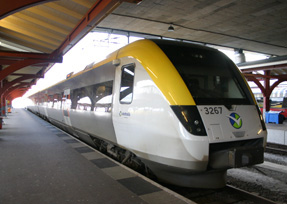Railways are one of the most energy efficient forms of transportation, with the lowest volume to emissions ratio. Energy efficiency in railways deals with reducing the amount of energy consumed by rail travel and reducing carbon emissions and other pollutants that occur due to the process. AEA Technology conducted a study analyzing the difference in environmental impact between a Eurostar train and an airline journey between London and Paris. Trains were found to emit 10 times less CO2 per passenger than a plane. In the US railways account for just 4% of the overall vehicular emissions generated. Freight transport in the railways sector is also immensely popular. The high volume, low value of transporting freight via this mode of transportation makes it economically feasible.
Energy efficiency for railways is closely connected to technological development.� The cost of energy to power railway networks can be quite substantial. The cost of running 3 of the largest European railway networks is 1.75 Billion Euros. Costs are also the hurdle in the drive for a more energy efficient railway network. The Japanese have developed a hybrid train that boosts fuel efficiency by 20% with almost 60% reduced emissions. However at US $1.7 million the cost of this train is double that of a normal train.
Initially one of the main forms of powering rail locomotives was using coal. Though considered efficient at the time it produced a large amount of harmful byproducts in the environment.
After coal came electricity, which proved to be a cleaner and more efficient fuel. Today advances in rail technology strive to cut down costs and emissions in railways further. Electricity is provided to the train via a third rail, overhead wires or generated on the train such as in a diesel electric locomotive. Efficiency in low voltage DC rail systems can be improved by increasing the cross section of the overhead catenary wires. Larger cross sections are more economically viable especially when undertaking new electrification projects.
Pollution that is generated in the process of powering these trains occurs at a distant power station. Using an energy efficient and eco friendly source of power to run these power stations can drastically reduce harmful pollutants. An example of this is the French SNCF (Société Nationale des Chemins de fer français) and Swiss Federal Railways who generate their power in power plants via hydro electric or nuclear power stations.
To ensure that a railway system is energy efficient modern energy saving technologies must be implemented. This includes the use of dry cast resin transformers and vacuum switch gear. Though these may be common in European countries they are often not found in Asia’s third world countries where railways are used intensively. With innovations in hybrid trains on the way after the success of hybrid cars, it is expected that trains of the future will prove to be greener and more energy efficient. One possible solution for the future is Biofuel trains such as those being experimented with by Richard Branson’s Virgin trains.
...Read more
Close










